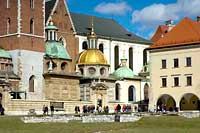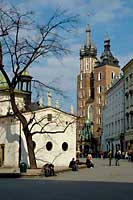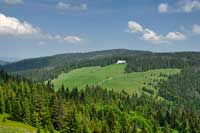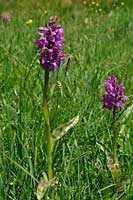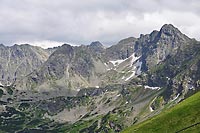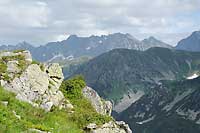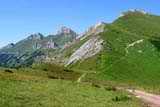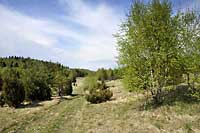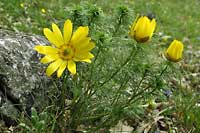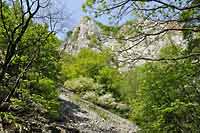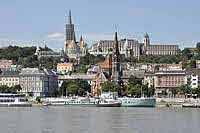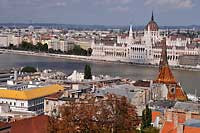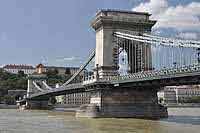CRACOW - BUDAPEST A BOTANICAL TRAVERSE
OF THE WEST CARPATHIAN MOUNTAINS
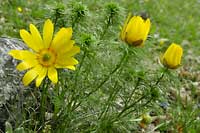
This botanical tour passes through the areas of the highest biodiversity in the West Carpathians and arguably the whole of Central Europe. However mountain flora is the principal target of this tour, providing opportunities to see interesting geological phenomena, mountain animals (including bears, if we are lucky ) and outstanding landscapes. The full day walks in the mountain areas follow routes which are well within the capabilities of any reasonably fit person who enjoys walking. The start and finish points - Cracow and Budapest - are both beautiful cities, which creates an additional attraction.
ITINERARY
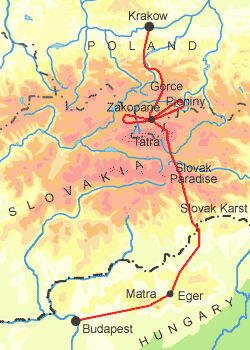
DAY ONE
Arrive in Cracow, transfer to hotel in the centre of the city. Dependent on the time, there will be a guided tour round the city or a shorter look around the old city. Before dinner a short presentation will introduce the botanical aspects of the tour.
DAY TWO
Transfer to Gorce Mountains National Park (60 km south from Cracow) followed by about six hours exploring the most interesting part of the Park. We will see impressive natural forest (Fagetum carpaticum) with spectacular old trees and typical flora, as well as flowery meadows. Over 900 vascular plants grow in the Gorce Mts. including: Aconitum moldavicum, Cardamine trifolia, Symphytum cordatum, Cortusa matthioli, Adenostyles alliaririae, Doronicum austriacum, Cicerbita alpina, Veratrum lobelianum, Galanthusnivalis.
Overnight stay in Zakopane.
DAY THREE
A full day excursion to the Pieniny National Park (50 km from Zakopane) - an area of the greatest biodiversity in Poland, famous for its limestone pinnacles and a spectacular rocky gorge through which the Dunajec river flows. Over 1100 species of vascular plants are listed from the Pieniny Mountains including endemic: Erysimum pieninicum and relic Dendranthema zawadzkii, Juniperus sabina, Conioselinum vaginatum, Dryas octopetala, mountain species: Minuartia setacea, Gypsophila repens, Astragalus australis etc. There are also xerothermic plants e.g. Draba nemorosa, Melica transilvanica, Inula ensifolia, Ophrys insectifera.
After visiting this scenic area we will return to Zakopane for an overnight stay.
DAY FOUR
A full day excursion to the High Tatra - Gasienicowa Alp area. Weather permitting we will ascend by cable car to Kasprowy Wierch (1985 m) and then descend through the granitic part of the Tatra. The Tatras are the highest part of the Carpathians with glacial relief and fully developed vegetational zones. All the Tatra massif is protected as a national parkand transboundary biosphere reserve. Overnight stay in Zakopane.
Selected plants listed from the Tatra: Androsace lactea, Anemone narcissiflora, Bartsia alpina, Campanula alpina, Cerastium tatrae, Cicerbita alpina, Cochlearia tatrae, Dianthus glacialis, Doronicum clusii. Dryas octopetala, Erigeron hungaricus, Erysimum wahlenbergi, Gentiana frigida, Gentiana punctata, Geum montanum, Gypsophilarepens, Leontopodium alpinum,Pedicularis oederi, Pinguicula alpina, Primula minima, Ranunculus alpestris, Ranunculus glacialis, Salix herbacea, Salix reticulata, Saxifraga paniculata, Saxifraga caesia, Saxifraga carpatica, Senecioabrotanifolius, Silene acaulis.
DAY FIVE
Excursion to Orava Basin (30 km from Zakopane) to explore an area of mountain peat-bogs, very rare in the Carpathians. Typical vegetation includes: Sphagnum sp. Pinus x rhetica, Ledum palustre, Vaccinium uluginosum, Oxyccocus quadripetalus, Andromeda polifolia, Eriophorum vaginatum, Rynhosphora alba, Drosera rotundifolia. Afternoon free to explore Zakopane, or visit the Botanical Field Station of the Polish Academy of Science.
Overnight stay at the same place.
DAY SIX
In the morning we cross the border between Poland and Slovakia, followed by an excursion to the Bielanske Tatry area (limestone + dolomite) with very rich flora. Demanding or easy walks can be made, depending on participants' abilities.
Overnight stay in Spisska Nova Ves or the vicinity.
DAY SEVEN
A full day excursion to SLOVAK PARADISE (it is true!). It is a beautiful scenic area rich in natural values. Typical forms of the landscape are plateaux, deep canyons, gorges, waterfalls, surface karstic
phenomena and caves. The longest gorge (11km) is the scenic Hornad River valley with an exciting rocky path. It is area approx. 30 km long and 20 km wide. The plateaux is covered by forest (mostly coniferous and beech) but on the rocks there are rich plant communities with some botanical rarities. There is a great choice of tourist trails of varying difficulty. We will select the most appropriate routes to provide a full day in paradise!
Overnight stay at the same place.
Selected plants listed from Slovensky Raj:
Aconitum anthora, A. moldavicum, Adenophora liliifolia, Anemone sylvestris, Aster serpentimontanus, Campanula carpatica, C. cochlearifolia, Carex humilis, Cerasus mahaleb, Cirsium eriophorum, Clematis alpina, Cyanus mollis, Daphne cneorum, Delphinium elatum, Dryas octopetala, Erysimum vittmannii, Festuca tatrae, Gladiolus imbricatus, Haquetia epipactis, Hesperis nivea, Iris aphylla, Ligularia sibirica, Parnassia palustris, Phyllitis scolopendrium, Primula auricula, Pulsatilla alba, Pulsatilla slavica, Sedum album, Soldanella hungarica, Stipa pulcherrima, Teucrium montanum, Trisetum alpestre, Trollius europaeus.
DAY EIGHT
We continue by bus towards the south, visiting on the way some fine nature reserves in the Spiss (Zips) area, e.g. Drevenik, a travertine massif with very rich flora and vegetation growing near natural mineral springs. It will be also possible to see the enormous ruins of Spisski Hrad castle which is a World Heritage Site.
Overnight stay in Roznava or the vicinity.
DAYS NINE AND TEN
Two full day excursions exploring the Slovak/Hungarian Karst - an area of extraordinary biodiversity, protected as an international biosphere reserve. Among over 1400 species of vascular plants listed from this area are: Onosma tornense (endemic), Sesleria heufleriana , Crategus domicensis, Adonis vernalis, Anthericum ramosum, Asyneuma canescens, Dracocephalum austriacum, Erythronium dens-canis, Cytisus procumbens, Iris pumila, Linum flavum, Anemone silvestris, Stipa capillata, Limodorum abortivum, Himantoglossum adriaticum. It is also possible (and recommended !) to visit the fabulous cave system Baradla-Domica with the underground stream Styx - World Heritage Site. On day ten, evening transfer to Eger in Hungary, a beautiful old town surrounded by vineyards.
DAY ELEVEN
A visit to the area of volcanic mountains, Matra, very rich in flora with many Pannonian elements.
Overnight stay in Eger.
DAY TWELVE
Transfer to Budapest - a great city with many historical buildings, but also picturesquely situated between gentle hills on both banks of the Danube. A tour of the city, then the afternoon is free.
Overnight stay in Budapest.
DAY THIRTEEN
Time to shop or sightsee in Budapest before departure by train (connections via Berlin or Vienna) or plane. It will be possible to return to Cracow (400 km) by bus.
ESSENTIAL INFORMATION
ACCOMMODATION
We stay in comfortable hotel/rest-houses sharing two-bedded rooms with private facilities.
MEALS
Full board from dinner in Cracow until breakfast in Budapest. Packed lunches will be provided during field excursions.
TRANSPORT
A comfortable private coach.
GROUP SIZE AND STAFF
Maximum twenty, accompanied by biologist tour-leader plus local expert-guides.
PREFERED TIME
15 May - 15 July
LEVEL OF DIFFICULTY
This tour is graded medium. During the tour there will be several full day walks amongst high mountains, following routes which are well within the capabilities of any reasonably fit person who enjoys walking.









